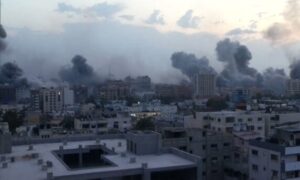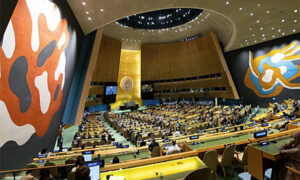
By Amar Diwakar
Scratch the surface, and the sectarian nature of the Syrian civil war is a subterranean expression of an utterly alienated majority involved in an intense class struggle. Evidently, it is the outward religiosity of these marginalized classes that many observers on the Anglophone left are obsessed with, and in the process have operationalized standard Islamophobic tropes that play directly into Assad’s hands and afflict upon the conflict a toxic dualism through which it continues to be rendered.
Revolution & Class
While the first sparks of Arab Spring largely occurred in urban areas across Tunisia, Egypt, Libya, and Yemen, in Syria it was chiefly a revolt of the peasantry. It was a protest by the Sunni periphery against what was perceived as the Ba’ath regime turning its back on the country’s rural population. Hence why the earliest sites of the insurgency were in smaller towns and cities located in impoverished regions, from Daraa in the south to Idlib in the north.
When the revolution came to the cities, the sociological divide between those siding with the regime and revolution was more pronounced. The Sunni business class was solidly tied to the regime, as well as much of the secular and established Alawite and Christian middle class, if not reluctantly due to the oppositional makeup: a movement of the Sunni peasantry and urban poor, with an orthodox religious outlook.
This is the socio-economic context in which the revolution would arrive. Unlike in Egypt and Tunisia, the Syrian capitalist class has been materially wedded to the Ba’ath. Might this partially account for western imperialism’s protracted trepidation? After all, what segment of the ruling class could fill the vacuum of a post-Assad Syria?
Michael Karadjis explains how the Syrian revolution is a mirror image of the uprising in Bahrain, observed in similar class-sectarian terms. In Bahrain, a Sunni minority ruled over a Shiite majority, and the uprising naturally channeled the exasperation of the disadvantaged urban and rural populace within a Shiite vocabulary. The Bahraini regime, along with their Saudi-led patrons, then sought to malign the uprising as an Iranian-sponsored fifth column. In contrast, Syria, where a state dominated by an Alawite elite (and a hybrid Sunni capitalist class) ruled over a Sunni majority, the regime and its Russian-Iranian backers attempted to smear the revolution of the Sunni periphery as a Gulf-sponsored fifth column.
False Binaries
Assad, the clean-shaven fascist, and the Ba’ath are as much ‘secular’, as they are ‘socialist’ or ‘anti-imperialist’. Atheism was prohibited; there was no civil code for personal law; and Alawites dominated in the state-security apparatus.
When it comes to the Islamic world, the Western eye has tended to conflate secularism with what Syrian communist Yassin al-Haj identified as “Huntingtonian secularism”: one that culturally oversimplifies and detaches itself from politico-economic reality to be pitted against a theocentric, orthopraxic, totalizing version of Islam. The idea that Assad signifies a generous secularism, as opposed to a virulent sectarianism, is simply absurd.
To subscribe to this spurious binary of secularism versus Islamism is to lack a basic historical and political awareness of the region. The consequences of defeat to Israel in 1967 and 1979 Iranian Revolution have to be accounted for in any serious attempt to understand the phenomenon of religion. The revival of Islam as a political program was in large part a response to the failures of Arab nationalism and the elimination or co-optation of the left in the Arab world. It responded to popular dissatisfaction with a corrupt economic, cultural and social order, and filled welfare gaps for those disenfranchised during the phase of neoliberal restructuring.
It might come as a surprise that Islamism is a flexible ideology: while typically inclined to the right, it easily can absorb the tenor of anti-imperialism whilst subsuming the register of nationalism into its discourse. This has allowed it to traverse various political cosmoses in praxis: be it bourgeois democracy, dictatorship, liberation theology, or apocalyptic nihilism.
In response to Assad’s violent sectarianism, intensification of not only religiosity but of Sunni identitarianism and sectarian resentment would firmly manifest. The context here is not complicated to gauge. A counter-insurgency strategy predicated upon the ethnic cleansing of Sunnis, coupled with a general amnesty of hundreds of Islamists from Sednaya, did much to trigger a dynamic of radicalization, militarization, and Islamization.
The aborted international protection of ongoing peaceful protests in the face of a brutal regime offensive, which Syrians called upon six months into the revolution, cannot be ignored either. The assumption was that the international community would intervene on humanitarian grounds to halt the escalating carnage, as it did in Yugoslavia, Iraq, and Libya. When it never materialized, the rise of armed resistance outfits began to dominate the opposition. Is it any wonder that bereft of substantial support and resources to survive, desperation in the face of barbarism would produce a reactionary after effect?
There was also an external factor that contributed to the opposition’s ongoing destabilization: rentier petrodollars from the Gulf, whether state-funded or private. However, the Salafist mutation amongst Islamists cannot be reduced to an effect of an imported Wahhabism; rather, it is related to the early globalization of Islamism in the 1980s. Warring conditions have been an ideal environment for Salafi jihadism to thrive.
Starved for crucial armaments to resist Assad’s blitzkrieg, rebels gravitated towards the more superior-funded Islamist brigades. Unimpeded, Assad implemented a brutal scorched earth policy, traumatizing civilians, and breeding space for jihadism to flourish. Fred Hof, a former state department official, described the Assad-Daesh collusion as one that was united in achieving their top tactical priority: to extinguish the Syrian nationalist opposition.
Wither Syrians?
Noticeably absent in the grand theater of geopolitics have been the Syrian people themselves. Their perspectives have been regularly sidelined from conversations about the fate of the Assad regime, Daesh, and the refugee crisis.
For the first time in four decades of Ba’athist rule, Syrians had participated in daring democratic experiments of self-organization in their daily lives through local councils. During an abridged yet immensely impactful service to the revolution, Damascene anarchist Omar Aziz provided an enduring example of radical grassroots organizing to have emerged from the turbulence of the Arab Spring.
However, in the context of ongoing revolution, the necessity of the immediate present understandably outweighs the necessity of long-term alternative political configurations that can be the foundation for a post-Assad Syria. What ordinary Syrians achieved under the most demanding of circumstances, whether in the face of brutal regime violence or apocalyptic Islamism has been remarkable.
In a post-conflict future, only Syrians can and should be the agents of their emancipation. What is certain is that no oppositional settlement can be feasible as long as Assad – the purveyor of death to over 90% of Syrian lives taken in the war – remains in power.
The inconsistent, hypocritical moral handwringing is apparent when a ‘war on terror’ narrative strangles the Syrian revolution. Interesting how it is acknowledged that occupation, whether in Palestine or Iraq, can fuel extremism but somehow Ba’athist massacres do not. Counter-revolution does not exist in a bubble; when you starve people of liberty and justice, along with quashing their right to defend themselves from a superior military force, the consequences are dreadfully similar.
Amar Diwakar a writer and research consultant with Global Risk Intelligence. Amar has an MSc in International Politics from SOAS, University of London.
(This article first appeared on Splintered Eye . To read the original article click here.)


















